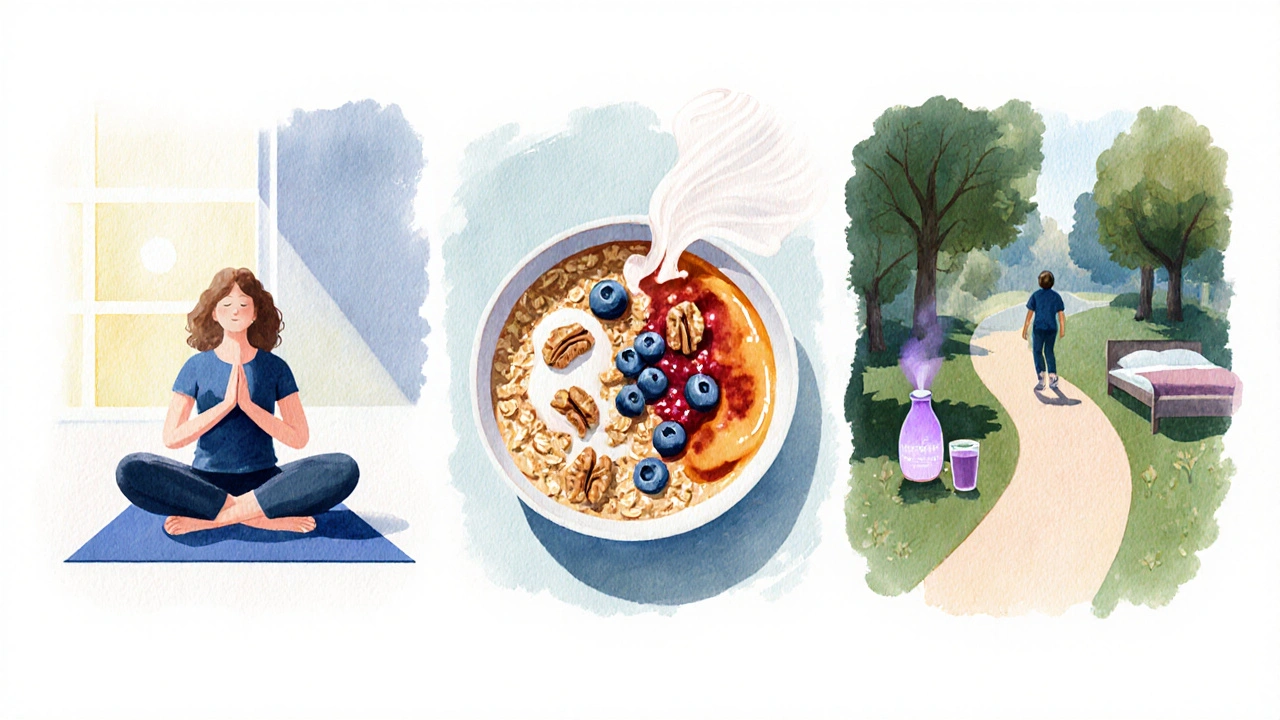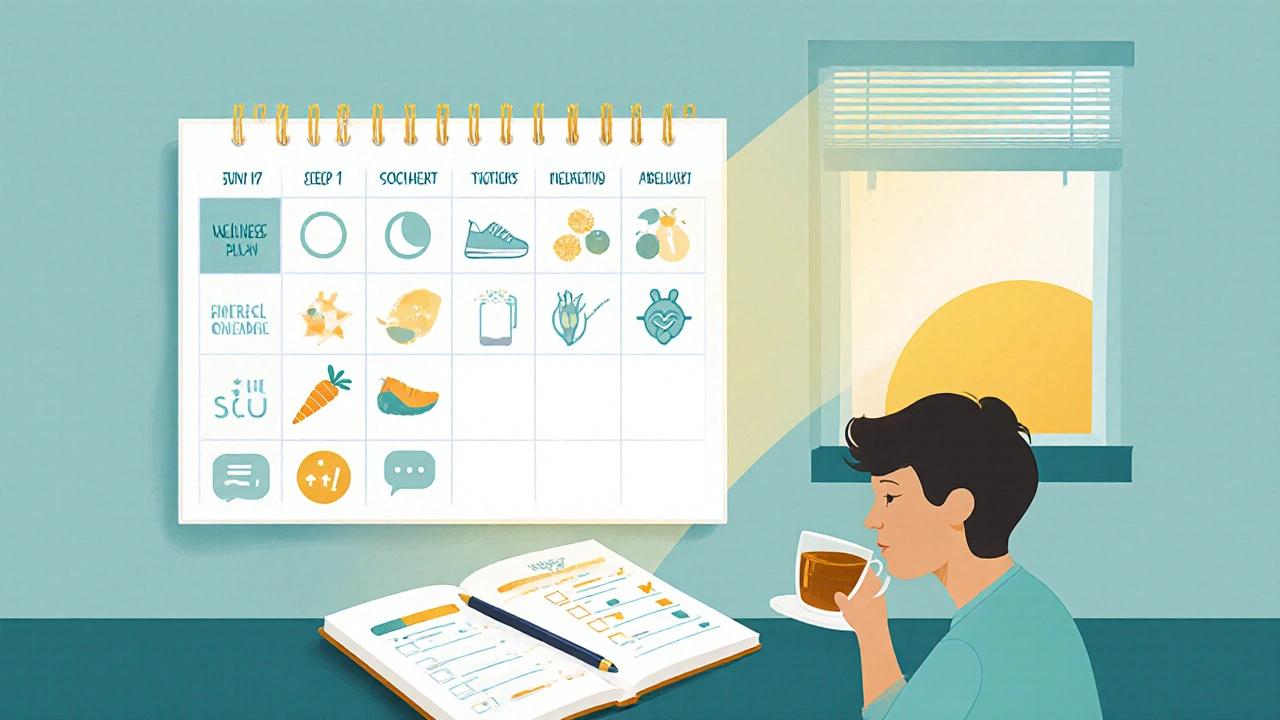
Holistic Stress Reduction Planner
Select Your Focus Pillars
Breathwork
Practice 4-7-8 breathing for 5 minutes daily.
Nutrition
Include magnesium-rich foods and limit caffeine after 2pm.
Movement
30-minute walks or gentle exercise 3x/week.
Sleep
Maintain 7-9 hour sleep schedule with blue light filter.
Sensory Care
Use aromatherapy (lavender, bergamot) to calm the nervous system.
Gut Health
Add fermented foods and prebiotic fibers to support serotonin.
Your Weekly Progress Tracker
Progress towards completing your selected pillars (0% = none, 100% = all)
| Pillar | Status | Notes |
|---|---|---|
| Select pillars above to begin tracking | ||
Daily Habit Reminder
Daily Tip: Start with 3 breaths in, 4 breaths hold, 8 breaths out. Practice this upon waking and before bed.
Weekly Goal: Add one new pillar each week to your routine.
Quick Take
- Holistic stress reduction blends mind, body, and environment.
- Focus on five pillars: breathwork, nutrition, movement, sleep, and sensory care.
- Start with a 10‑minute daily breathing practice, then add one lifestyle tweak each week.
- Track progress with a simple journal: mood, energy, and sleep quality.
- Avoid common traps like “quick fixes” that ignore underlying habits.
When it comes to stress reduction, a holistic view looks at body, mind, and environment together. Instead of chasing a single miracle cure, you combine several low‑effort habits that reinforce each other. This guide breaks down the most effective pillars, shows how to stitch them into a daily routine, and flags the pitfalls that keep many people stuck.
What a Holistic Approach Actually Means
A holistic approach treats stress as a system‑wide signal, not just a mental hiccup. It acknowledges that hormones, gut microbes, breath, and social ties all shape how we feel. By tuning each part, the overall stress load drops dramatically.
Key idea: small, consistent actions compound over weeks. Think of it as tending a garden-water a little, pull weeds, add fertilizer, and the garden flourishes without a sudden overhaul.
Core Pillars of Holistic Wellness
1. Mindfulness & Breathwork
Mindfulness is the practice of staying present without judgment. Pair it with slow diaphragmatic breathing (4‑7‑8 technique) to trigger the parasympathetic nervous system, which calms cortisol.
- Start with 3 breaths in, 4 breaths hold, 8 breaths out.
- Do this upon waking and before bed for a 5‑minute reset.
2. Nutrition for a Calm Body
Nutrition influences stress through blood‑sugar stability and neurotransmitter production. Foods rich in magnesium, B vitamins, and omega‑3s support a relaxed nervous system.
- Breakfast: oatmeal topped with walnuts, blueberries, and a splash of kefir.
- Lunch: mixed greens, quinoa, grilled salmon, and a drizzle of olive oil.
- Snack: a handful of pumpkin seeds or dark chocolate (70%+).
Limit caffeine after 2p.m. and swap refined carbs for complex whole grains to avoid spikes that trigger anxiety.
3. Physical Activity & Movement
Exercise releases endorphins, improves sleep, and reduces the hormone adrenaline. You don’t need marathon training-consistent moderate movement works best.
- Three 30‑minute sessions per week: brisk walk, body‑weight circuit, or yoga flow.
- Incorporate micro‑breaks: stand and stretch every hour if you sit at a desk.
4. Sleep Hygiene
Sleep is the body’s natural reset button. Aim for 7‑9 hours of uninterrupted rest.
- Dim lights 1hour before bed; use a blue‑light filter on devices.
- Keep bedroom temperature around 18‑19°C (65‑66°F).
- Establish a wind‑down ritual: reading, gentle stretching, or a few minutes of gratitude journaling.
5. Aromatherapy & Sensory Care
Aromatherapy leverages scent‑triggered limbic pathways to calm the mind. Lavender, bergamot, and frankincense are evidence‑backed for reducing cortisol.
- Diffuse 3‑4 drops of lavender oil during evening wind‑down.
- Apply a diluted blend to pulse points after shower.
6. Gut Health Connection
Gut health matters because 90% of serotonin is produced in the intestines. A varied, fiber‑rich diet feeds beneficial bacteria that communicate with the brain.
- Include fermented foods: kimchi, sauerkraut, or kombucha.
- Take a probiotic containing Bifidobacterium and Lactobacillus strains, especially during high‑stress periods.
7. Social Connection & Purpose
Social connection buffers stress hormones. Even brief, meaningful chats trigger oxytocin release, which opposes cortisol.
- Schedule a weekly coffee or video call with a friend.
- Join a community group aligned with a hobby you love.

Designing Your Personal Holistic Routine
- Assess your current stress triggers. Write down three situations that spike your anxiety.
- Pick one pillar to start with. If you struggle with sleep, begin with the bedtime ritual.
- Set a micro‑goal: e.g., “Do the 4‑7‑8 breathing exercise for 5 minutes after lunch for 7 days.”
- Track daily: use a simple table (see below) to note mood (1‑10), energy (1‑10), and sleep quality (hours).
- After two weeks, add a second pillar. Rotate until all seven are habit‑stacked.
- Review monthly: if mood scores improve by at least 2 points, the habit is effective. If not, tweak dosage or timing.
Quick Comparison: Holistic vs Quick‑Fix Strategies
| Aspect | Holistic Approach | Quick‑Fix (e.g., caffeine, alcohol) |
|---|---|---|
| Duration of Effect | Long‑term reduction, cumulative | Hours, then rebound |
| Side Effects | Minimal, supportive | Jitters, sleep disruption |
| Impact on Sleep | Improves quality | Often impairs sleep |
| Cost | Low‑to‑moderate (food, apps, essential oils) | Variable, can be high (energy drinks, medication) |
| Root Cause Addressed | Yes - hormones, gut, mind‑body loops | No - masks symptoms |
Common Pitfalls and How to Dodge Them
- Doing too much at once. Overloading yourself leads to burnout. Stick to one habit for 14 days before adding another.
- Expecting instant results. Stress hormones take weeks to rebalance. Keep the journal and look for subtle trends.
- Relying on “quick fixes”. Caffeine, sugar, or alcohol may feel soothing but feed the stress cycle later.
- Neglecting consistency. Missed days reset progress. Build habits around fixed cues-like “after I brush my teeth”.
- Skipping self‑compassion. If a day goes off‑track, acknowledge, reset, and move forward.
Next Steps: Your 30‑Day Launch Plan
Week1 - Breathwork & Sleep.
- Morning: 5‑minute 4‑7‑8 breathing.
- Evening: No screens after 9p.m., use lavender diffuser.
Week2 - Nutrition.
- Add a magnesium‑rich snack (almonds, dark chocolate) after lunch.
Week3 - Movement.
- Three 30‑minute walks, schedule on calendar.
Week4 - Gut & Social.
- Include a fermented food at dinner.
- Call a friend for a 15‑minute catch‑up.
At the end of the month, review your journal. If you see a steady rise in mood and better sleep, keep the routine and fine‑tune as needed.

Frequently Asked Questions
Can I practice mindfulness if I never meditated before?
Absolutely. Start with just one minute of focusing on your breath. The goal isn’t to empty the mind, but to notice when thoughts drift and gently bring attention back. Consistency beats duration.
How much caffeine is safe during a stress‑reduction plan?
Most adults tolerate up to 400mg per day (about four cups of coffee). If you’re sensitive, limit intake to before noon and watch for jittery feelings that signal you’re overdoing it.
Do essential oils really lower cortisol?
Research shows inhaling lavender or bergamot for 15 minutes can cut cortisol by up to 12% in lab settings. The effect isn’t a miracle cure but a helpful adjunct when paired with other habits.
What’s the quickest way to improve gut health for stress?
Add a serving of fermented food daily-like a tablespoon of kimchi or a cup of kefir. Pair it with a prebiotic fiber source (e.g., sliced banana or cooked oats) to feed the good bacteria.
How long before I see results from a holistic stress plan?
Most people notice subtle mood lifts and better sleep after 2‑3 weeks of consistent practice. Major shifts in baseline stress levels typically emerge after 6‑8 weeks.





